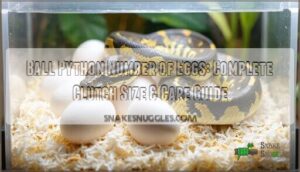This site is supported by our readers. We may earn a commission, at no cost to you, if you purchase through links.

Think of it like a small family – not overwhelming, but just right for a dedicated snake mom. First-time mothers often start smaller with 3-5 eggs, while experienced females can surprise you with up to 12.
Your snake’s age, weight, and health play starring roles in determining clutch size. Unlike the "lay and leave" approach of many reptiles, ball python mothers are helicopter parents who’ll coil around their precious eggs for two whole months without eating.
Understanding these patterns helps you prepare for what’s coming next.
Table Of Contents
- Key Takeaways
- Ball Python Egg Clutch Size and Incubation
- Caring for Ball Python Eggs
- Incubator Setup for Ball Python Eggs
- Egg Viability and Hatchling Success
- Frequently Asked Questions (FAQs)
- How many eggs does a ball python lay?
- Do pythons lay eggs?
- Do ball pythons incubate their own eggs?
- When do captive ball pythons lay their eggs?
- How long do Ball Python Eggs take to hatch?
- How long do Ball Python eggs last?
- Can you leave a heat lamp on 24/7 for ball python?
- How long is a ball python’s gestation period?
- How many clutches do ball pythons have a year?
- How long after mating will a ball python lay eggs?
- Conclusion
Key Takeaways
- Your ball python will typically lay 4-8 eggs per clutch, with 6 being the most common number, though first-time mothers often start smaller with 3-5 eggs while experienced females can produce up to 12.
- You’ll need to maintain precise incubation conditions at 88-90°F with 85-95% humidity for 55-60 days, whether you choose natural maternal incubation or use an artificial incubator setup.
- You can expect about 88.6% viability rates from healthy eggs, which you’ll identify through candling techniques that reveal pink coloration and visible blood vessels, while infertile "slug" eggs appear yellow and lifeless.
- Your female will fast completely during the 55-60 day incubation period if she’s naturally incubating, coiling protectively around her clutch and only leaving briefly for basking while maintaining consistent temperatures through muscle contractions.
Ball Python Egg Clutch Size and Incubation
Your ball python will typically lay between 3 to 11 eggs per clutch, with most females producing around 5 to 7 eggs during each breeding season.
These eggs need steady temperatures of 88-90°F and take about 55-60 days to hatch, whether you let mom handle the job or use an artificial incubator.
Average Clutch Size
When breeding season arrives, your ball python’s clutch size typically ranges from 4-8 eggs, with 6 being most common.
Don’t expect cookie-cutter consistency though – each female writes her own story.
Clutch Size Factors that influence your python’s egg count include:
- First-time mothers usually lay smaller clutches (3-5 eggs)
- Larger, mature females produce more eggs (up to 12)
- Captive vs wild conditions affect clutch consistency
- Female age and overall health matter substantially
- Environmental temperature impacts egg production
Throughout your python’s females lifespan, you’ll notice clutch consistency varies.
A healthy female can lay a clutch every year, and may produce around 125 eggs over 25 years.
Understanding these python egg count patterns helps you prepare properly for successful breeding seasons ahead.
Incubation Period
After your ball python lays her clutch, the ball python egg incubation countdown begins. The incubation period spans 55-60 days, demanding your attention like a watchful parent.
Temperature stability at 88-90°F paired with humidity control between 85-95% creates the perfect nursery. A reliable incubator is part of essential supplies and setup.
Here’s your python egg development checklist:
- Maintain steady heat like a cozy blanket
- Monitor moisture levels religiously
- Handle eggs gently—no flipping allowed
- Candle weekly to check viability
Hatchling health depends on consistent conditions throughout incubation duration.
Gravidity and Egg Laying
After your female completes her incubation period, you’ll spot clear signs she’s ready for the egg laying process.
Her swollen belly becomes obvious as eggs develop inside.
Appetite changes hit hard – she might stop eating entirely or become pickier than usual.
Lethargy signs appear as she conserves energy for what’s ahead.
The average python eggs per ball python clutch size ranges from 3-14, but most lay 5-6 eggs.
Watch for egg-binding risks, which can turn deadly fast.
Veterinary checks during gravidity guarantee everything progresses smoothly for both mom and her future hatchlings.
One interesting fact is that parthenogenesis has occurred in captive ball pythons.
- Swollen belly indicates eggs developing inside your female
- Appetite changes signal the approaching ball python egg laying event
- Lethargy is completely normal behavior in gravid females
- Egg-binding can become a life-threatening emergency requiring immediate vet care
- Veterinary check-ups help guarantee a safe, successful breeding process
Caring for Ball Python Eggs
Once your ball python lays her clutch of 3-11 eggs, you’ll face a pivotal decision between letting mom handle the job naturally or taking control with an artificial incubator.
Both methods work well, but each requires different skills and equipment—kind of like choosing between a home-cooked meal and a fancy restaurant.
Maternal Incubation
When you allow maternal incubation, your female becomes a living thermostat.
She’ll coil tightly around her clutch, using natural thermoregulation to maintain perfect conditions.
During this female fasting period, she won’t eat for 55-60 days, dedicating herself entirely to clutch protection.
Her hatching defense instincts kick in – she’ll only leave for limited basking, making ball python egg care completely hands-off.
Artificial Incubation
While mom’s doing her thing, you might prefer taking control with artificial incubation.
This method gives you the upper hand when managing multiple clutches or nervous first-time mothers.
Here’s your game plan for incubator setup:
- Remove eggs carefully from the female, marking their original position
- Set temperature control at 88-90°F using digital incubators for stability
- Maintain humidity management between 85-95% with proper ventilation methods
- Monitor hatchling health through regular candling checks
Incubator technology beats guesswork every time.
A proper setup requires a quality ball python incubator.
Incubator Setup for Ball Python Eggs
Setting up the perfect incubator setup transforms your ball python breeding from guesswork into guaranteed success. Digital incubators offer precise temperature control and humidity management, automatically maintaining the vital 88-90°F range your eggs demand.
Your essential toolkit includes:
- Temperature Stability: Consistent heat prevents developmental disasters
- Humidity Control: Proper moisture levels guarantee healthy embryo growth
- Ventilation Needs: Fresh airflow prevents deadly mold formation
- Monitoring Tools: Reliable thermometers and hygrometers track conditions 24/7
Circulated air systems distribute heat evenly, eliminating dangerous hot spots. A key component is the reptile egg incubator. Always conduct a test run before adding precious eggs—think of it as your incubator’s dress rehearsal before the main performance.
Egg Viability and Hatchling Success
Most ball python eggs show promising viability rates, with approximately 88.6% developing successfully under proper conditions. Your candling techniques will reveal healthy eggs through their pinkish glow and visible veins, while infertile eggs (called slugs) appear yellowish and lack development.
**Strong, viable eggs glow pink with visible veins—slugs stay yellow and lifeless.
Environmental impact plays a vital role—consistent temperatures prevent incubation failures that could affect hatchling health. Optimal incubation temperature greatly influences survival rates.
Here’s your roadmap to maximizing hatchling success:
- Weekly candling – Check for pink coloration and blood vessel networks
- Remove slugs immediately – Prevent mold from spreading to viable eggs
- Monitor genetic factors – Some morphs have lower hatch rates than others
- Track development progress – Healthy eggs grow noticeably larger over time
Remember, roughly 75% of large clutches hatch successfully, so don’t panic if some eggs don’t make it—that’s completely normal.
Frequently Asked Questions (FAQs)
How many eggs does a ball python lay?
Surprisingly, your scaly friend won’t overwhelm you with hundreds of babies.
Ball pythons typically lay 3-11 eggs per clutch, averaging 5-7 eggs.
Larger, healthier females produce more eggs than smaller ones.
Do pythons lay eggs?
Yes, pythons do lay eggs! They’re oviparous reptiles, meaning you’ll find them coiling protectively around their clutches.
Most python species lay between 5-20 eggs per clutch, though larger species can produce up to 100 eggs.
Do ball pythons incubate their own eggs?
Female ball pythons naturally incubate their own eggs by coiling tightly around them for 55-60 days.
They’ll maintain consistent temperature through muscle contractions and won’t eat during this protective period until hatching occurs, which is a remarkable display of maternal care.
When do captive ball pythons lay their eggs?
Ever wonder when your scaly friend will become a mom?
Captive ball pythons typically lay their eggs 60-90 days after mating, usually during spring or early summer when you’ve provided proper breeding conditions.
How long do Ball Python Eggs take to hatch?
Ball python eggs typically hatch after 50-60 days of incubation.
You’ll notice them becoming saggy before hatching begins.
Temperature and humidity levels in your setup directly affect this timeline, so consistent conditions are vital, ensuring the incubation period is not unnecessarily prolonged by fluctuations in temperature.
How long do Ball Python eggs last?
Like ticking time bombs, your ball python’s eggs don’t last forever once laid.
They’ve got a 50-60 day window before they hatch, but they’ll start deteriorating if conditions aren’t perfect throughout incubation.
Can you leave a heat lamp on 24/7 for ball python?
You shouldn’t leave heat lamps on constantly for ball pythons.
They need a day-night cycle with temperatures dropping 5-10°F at night.
Use ceramic heat emitters or under-tank heaters for nighttime warmth instead.
How long is a ball python’s gestation period?
Waiting, watching, and wondering about your gravid female?
You’ll experience a 50-60 day incubation period after she lays her eggs.
Temperature and humidity affect timing, so expect patience during this exciting journey.
How many clutches do ball pythons have a year?
Your female ball python typically produces one clutch per year, though some healthy adults can manage two clutches annually.
Most breeders expect a single clutch during the breeding season for ideal health.
How long after mating will a ball python lay eggs?
Good things come to those who wait!
After mating, you’ll typically see your ball python lay eggs within 30 to 45 days.
This timing can vary slightly based on her health and environmental conditions, which is a complete concept to consider when waiting for your ball python to lay eggs.
Conclusion
Now you’ve got the inside scoop on ball python number of eggs – like having a crystal ball for your snake’s reproductive future.
Whether you’re dealing with a first-timer’s modest 4-egg clutch or a seasoned mother’s impressive dozen, you’re prepared for the journey ahead.
Remember, successful breeding isn’t just about counting eggs; it’s about understanding your python’s unique needs, providing proper care, and respecting the incredible two-month incubation commitment these dedicated mothers make, which is a significant aspect of their reproductive future.







